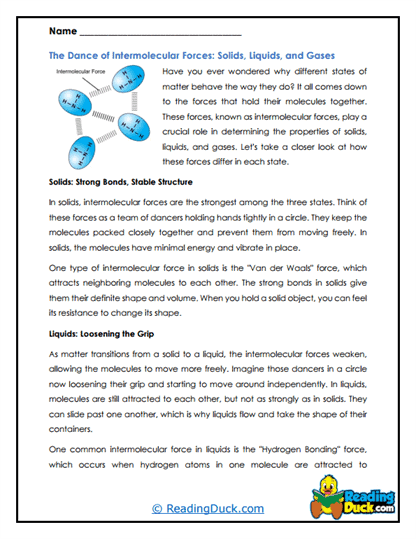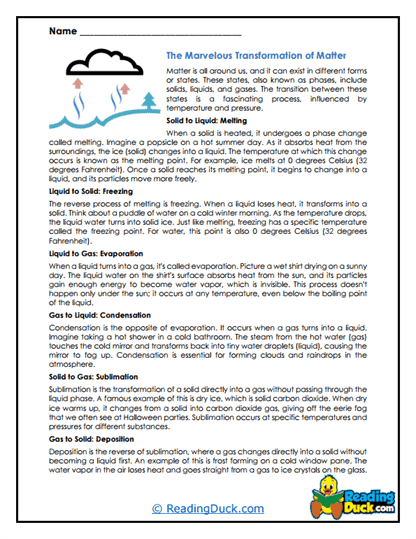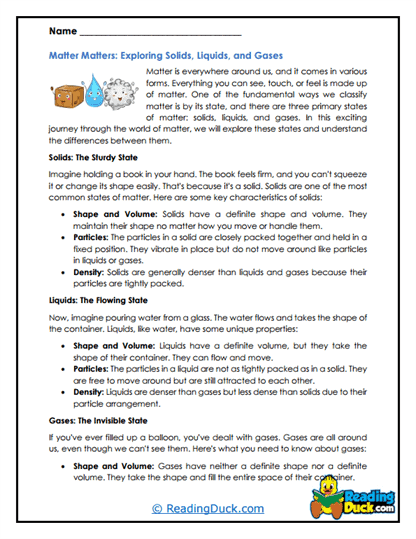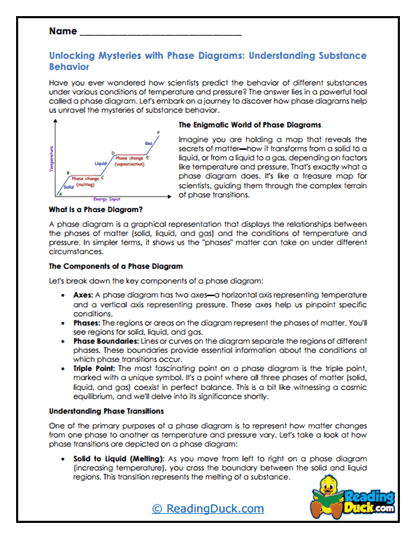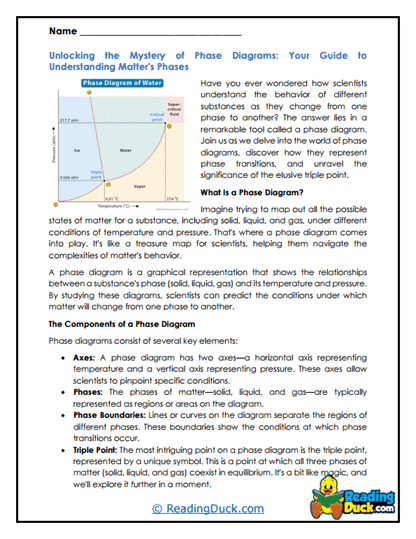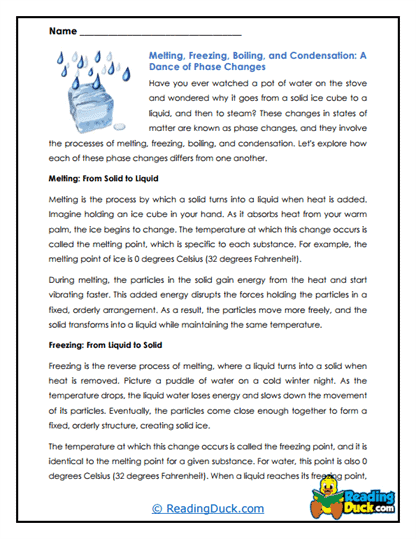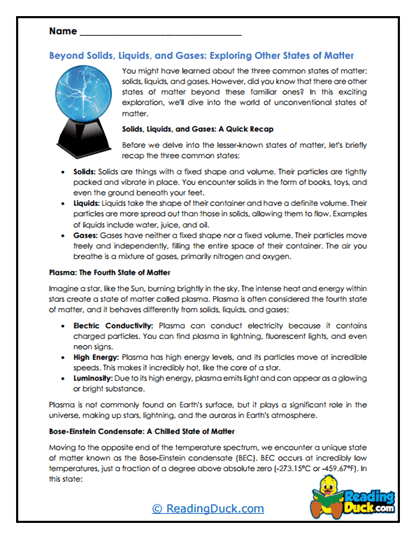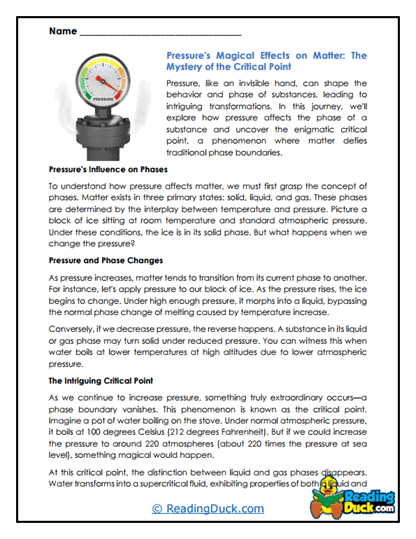Phases of Matter Worksheets
About Our Phases of Matter Worksheets
Our Phases of Matter worksheets offer a detailed exploration of the different states of matter, a fundamental concept in chemistry. This collection is designed to help students understand how matter changes from one phase to another and the underlying principles governing these changes. Through a variety of engaging and informative activities, students will gain a solid foundation in this essential topic.
This collection includes multiple worksheet sets, each structured to facilitate comprehensive learning:
- Multiple Choice Questions: These questions assess students’ understanding of the different phases of matter, including the characteristics of solids, liquids, gases, and plasma, and the conditions that cause matter to change from one phase to another.
- Short Answer Questions: These prompts encourage students to explain concepts in their own words, such as describing the process of melting, freezing, condensation, and evaporation, or identifying the conditions required for sublimation.
- Open-Ended Questions: These questions invite students to think critically about the phases of matter, such as discussing real-world applications of phase changes or exploring the energy changes involved in different processes.
Each worksheet set is designed to deepen students' understanding and connection to the material. The worksheets are provided in PDF format, making them easily accessible for electronic viewing, downloading, and printing.
Understanding the Phases of Matter: A Comprehensive Overview
1. The Basic Phases of Matter
- Solids:
- Structure and Characteristics: In solids, particles are tightly packed together in a fixed arrangement, which gives solids a definite shape and volume. The particles vibrate but do not move from their positions, making solids rigid.
- Examples: Common examples of solids include ice, metals, and wood. The structure of a solid can range from crystalline (like salt or diamonds) to amorphous (like glass).
- Liquids:
- Fluidity and Shape: Liquids have a definite volume but no fixed shape. The particles in a liquid are closely packed but can move past one another, allowing liquids to flow and take the shape of their container.
- Examples: Water, oil, and alcohol are typical examples of liquids. The surface tension and viscosity of a liquid are important properties that influence its behavior.
- Gases:
- Expansion and Compression: Gases have neither a fixed shape nor a fixed volume. The particles in a gas are far apart and move freely, allowing gases to expand to fill their container and be compressed under pressure.
- Examples: Air, helium, and carbon dioxide are common gases. The behavior of gases can be explained by the kinetic molecular theory, which relates temperature and pressure to the motion of particles.
- Plasma:
- Ionized State: Plasma is an ionized gas, meaning it consists of free electrons and ions. This phase occurs at extremely high temperatures where atoms lose their electrons.
- Examples: Plasma is found in stars, lightning, and neon signs. It is the most common phase of matter in the universe, although it is less familiar on Earth.
2. Phase Changes: Transformations Between States
- Melting and Freezing:
- Melting: The transition from solid to liquid occurs when a solid absorbs enough heat energy to break the bonds holding its particles in place. The melting point is the temperature at which this happens.
- Freezing: The reverse process, freezing, occurs when a liquid loses enough energy to form a solid. The freezing point is the same as the melting point for a given substance, but the direction of energy flow is reversed.
- Evaporation and Condensation:
- Evaporation: When a liquid gains enough energy, its particles can escape from the surface and become a gas. Evaporation occurs at any temperature but is faster at higher temperatures.
- Condensation: Condensation is the process where gas loses energy and transitions back into a liquid. This process is commonly observed when water vapor in the air forms droplets on a cold surface.
- Sublimation and Deposition:
- Sublimation: This is the process where a solid changes directly into a gas without passing through the liquid phase, as seen with dry ice (solid carbon dioxide) sublimating at room temperature.
- Deposition: The opposite of sublimation, deposition occurs when a gas transitions directly into a solid. Frost formation is an example of deposition, where water vapor in the air turns directly into ice crystals.
- Vaporization and Boiling:
- Vaporization: Vaporization refers to the process of a liquid becoming a gas. It includes both evaporation and boiling.
- Boiling: Boiling is a type of vaporization that occurs when a liquid is heated to its boiling point, where bubbles of vapor form within the liquid and rise to the surface.
Activities to Supplement These Worksheets
To enhance the learning experience offered by our Phases of Matter worksheets, teachers and parents can incorporate a variety of hands-on activities and creative projects. These activities will not only reinforce the concepts covered in the worksheets but also encourage students to apply their knowledge in practical and engaging ways.
1. Phase Change Demonstration:
- Simple Lab Experiment:
- Activity: Perform a simple experiment where students can observe water changing from solid (ice) to liquid (water) to gas (steam). Use a heat source to melt ice, then continue heating the water until it boils and turns to steam.
- Objective: This experiment allows students to observe phase changes in real time, reinforcing their understanding of how energy affects the state of matter.
2. Create a Phase Change Diagram:
- Visual Learning Tool:
- Activity: Have students draw a diagram that illustrates the phase changes between solids, liquids, and gases. They should label each process (e.g., melting, freezing, evaporation, condensation) and indicate the direction of energy flow.
- Objective: This activity helps students visualize the relationships between different phases of matter and the energy changes involved.
3. Sublimation Experiment with Dry Ice:
- Hands-On Exploration:
- Activity: Safely demonstrate the sublimation of dry ice (solid carbon dioxide). Show how it transitions directly from a solid to a gas, and discuss the properties of carbon dioxide at room temperature.
- Objective: This experiment gives students a tangible example of sublimation and allows them to explore a less common phase change.
4. Interactive Phase Change Simulation:
- Technology Integration:
- Activity: Use an online simulation to allow students to manipulate the temperature and pressure of a substance and observe how it affects the phase of matter. Many educational websites offer interactive phase change simulations.
- Objective: This tool lets students experiment with phase changes in a virtual environment, providing a deeper understanding of the conditions that affect the state of matter.
5. Phase Change Storyboard:
- Creative Writing and Illustration:
- Activity: Ask students to create a storyboard that tells the “story” of a water molecule as it moves through different phases (ice, water, steam). They should illustrate and narrate what happens at each stage.
- Objective: This creative exercise encourages students to think narratively about scientific concepts, reinforcing their understanding of phase changes through storytelling.
6. Condensation and Evaporation in Action:
- Real-World Connection:
- Activity: Place a cup of hot water in a sealed plastic bag and a cup of cold water in another. After a few minutes, have students observe the condensation that forms on the inside of the cold cup's bag and discuss how this relates to the water cycle.
- Objective: This activity helps students connect phase changes to real-world phenomena, such as the water cycle and weather patterns.
7. Phase Change Poster Project:
- Collaborative Learning:
- Activity: Have students work in groups to create posters that explain different phase changes. Each group can focus on one type of phase change, such as melting, freezing, or boiling, and present their findings to the class.
- Objective: This project fosters collaboration and communication skills while reinforcing students’ understanding of phase changes.
8. Phase Change Jeopardy:
- Game-Based Learning:
- Activity: Organize a Jeopardy-style game with categories related to phases of matter, such as “Types of Phase Changes,” “Examples of Solids, Liquids, and Gases,” and “Energy and Matter.”
- Objective: This game serves as an interactive review, helping students reinforce their knowledge in a fun and competitive way.
9. Explore Plasma with a Plasma Ball:
- Interactive Demonstration:
- Activity: Use a plasma ball to demonstrate the properties of plasma. Explain how the ionized gas inside the ball responds to electric currents and discuss where plasma is found in the universe.
- Objective: This demonstration introduces students to plasma, the least familiar phase of matter, and connects their learning to real-world technology and natural phenomena.
By supplementing the Phases of Matter worksheets with these activities, teachers and parents can create an engaging and comprehensive learning experience. These activities not only reinforce theoretical knowledge but also encourage students to apply what they’ve learned in practical and creative ways, making the study of matter’s phases both fun and memorable.
